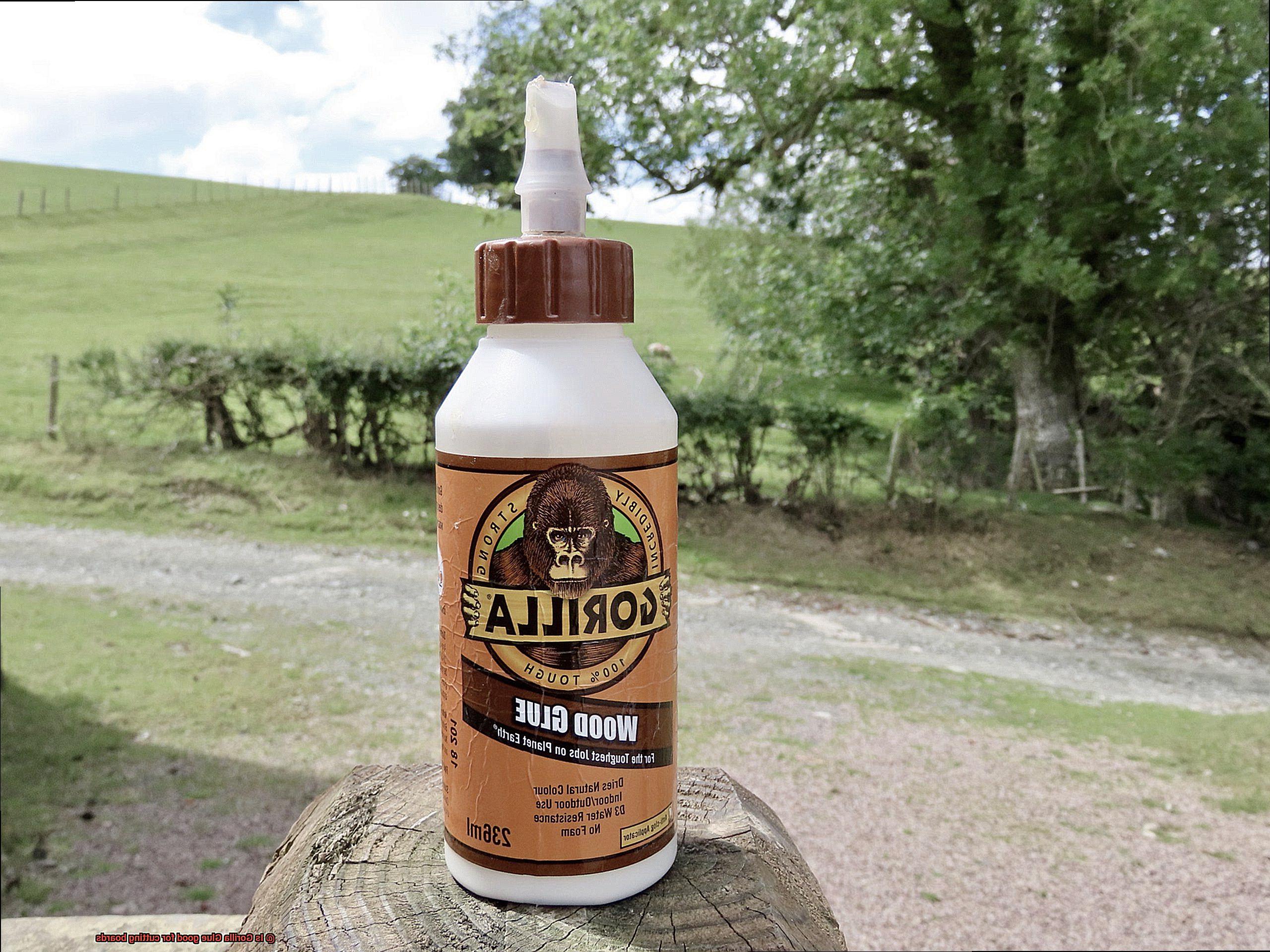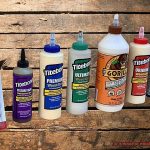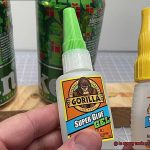Welcome to our blog post, where we tackle the burning question: “Is Gorilla Glue good for cutting boards?”
When it comes to picking the perfect glue for your trusty cutting board, you want something that’s safe, effective, and tough as nails. Enter Gorilla Glue – the heavyweight champ of adhesives.
But does it really deliver when it comes to cutting boards? In this post, we’re gonna spill the beans on the pros and cons of using Gorilla Glue.
So sit back, relax, and let’s get down to business.
What is Gorilla Glue?
Contents
- 1 What is Gorilla Glue?
- 2 Advantages of Using Gorilla Glue on Cutting Boards
- 3 Disadvantages of Using Gorilla Glue on Cutting Boards
- 4 Guidelines for Applying Gorilla Glue to Cutting Boards
- 4.1 Step 1: Clean and Dry – Show Your Board Some Love
- 4.2 Step 2: Smooth It Out – Embrace the Roughness
- 4.3 Step 3: Dampen the Surfaces – Moisture Is Key
- 4.4 Step 4: Apply Gorilla Glue – The Star of the Show
- 4.5 Step 5: Bring It Together – A Meeting of Surfaces
- 4.6 Step 6: Patience Is a Virtue – Let the Magic Happen
- 5 Is Gorilla Glue Food Safe?
- 6 Finishing the Board After Applying Gorilla Glue
- 7 Alternatives to Gorilla Glue for Cutting Boards
- 8 Conclusion
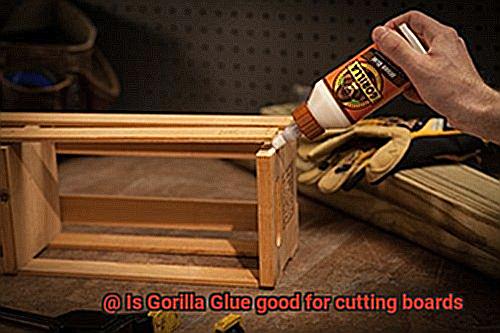
When it comes to adhesive, one brand that rises above the rest is Gorilla Glue. Renowned for its exceptional strength and versatility, Gorilla Glue is an all-purpose adhesive that can bond a wide range of materials together, including wood, metal, plastic, fabric, and more. Whether you’re working on a DIY project or need to make repairs around the house, Gorilla Glue is the go-to choice for professionals and enthusiasts alike.
One of the key features that sets Gorilla Glue apart is its unparalleled bond. Crafted with a polyurethane formula, this adhesive delivers a robust and long-lasting hold. As it cures, it expands, effortlessly filling in gaps and creating a watertight seal that can withstand extreme conditions like high heat or moisture. This makes it ideal for both indoor and outdoor applications, ensuring your projects stay intact even in challenging environments.
Gorilla Glue offers a variety of forms to cater to different needs. The liquid form is perfect for larger surface areas, allowing for easy application and coverage. Meanwhile, the gel form is specifically designed for vertical applications where dripping or running might be an issue. And when you’re in need of quick fixes or working in hard-to-reach places, Gorilla Tape provides an easy-to-use solution that delivers the same strength and reliability.
To ensure maximum adhesion, it’s crucial to dampen the surfaces before applying Gorilla Glue. This activates the glue and helps it set properly, ensuring a strong and secure bond. Once applied, the glue dries to a light tan color and can be sanded or painted over once fully cured, providing a seamless finish that blends seamlessly with your project.
While Gorilla Glue is known for its versatility, it’s important to note that it’s not suitable for use on materials that are sensitive to moisture or water, such as styrofoam or expanded polystyrene. It’s always recommended to carefully read the instructions and test the glue on a small area before committing to a larger project, ensuring compatibility and optimal results.
Advantages of Using Gorilla Glue on Cutting Boards
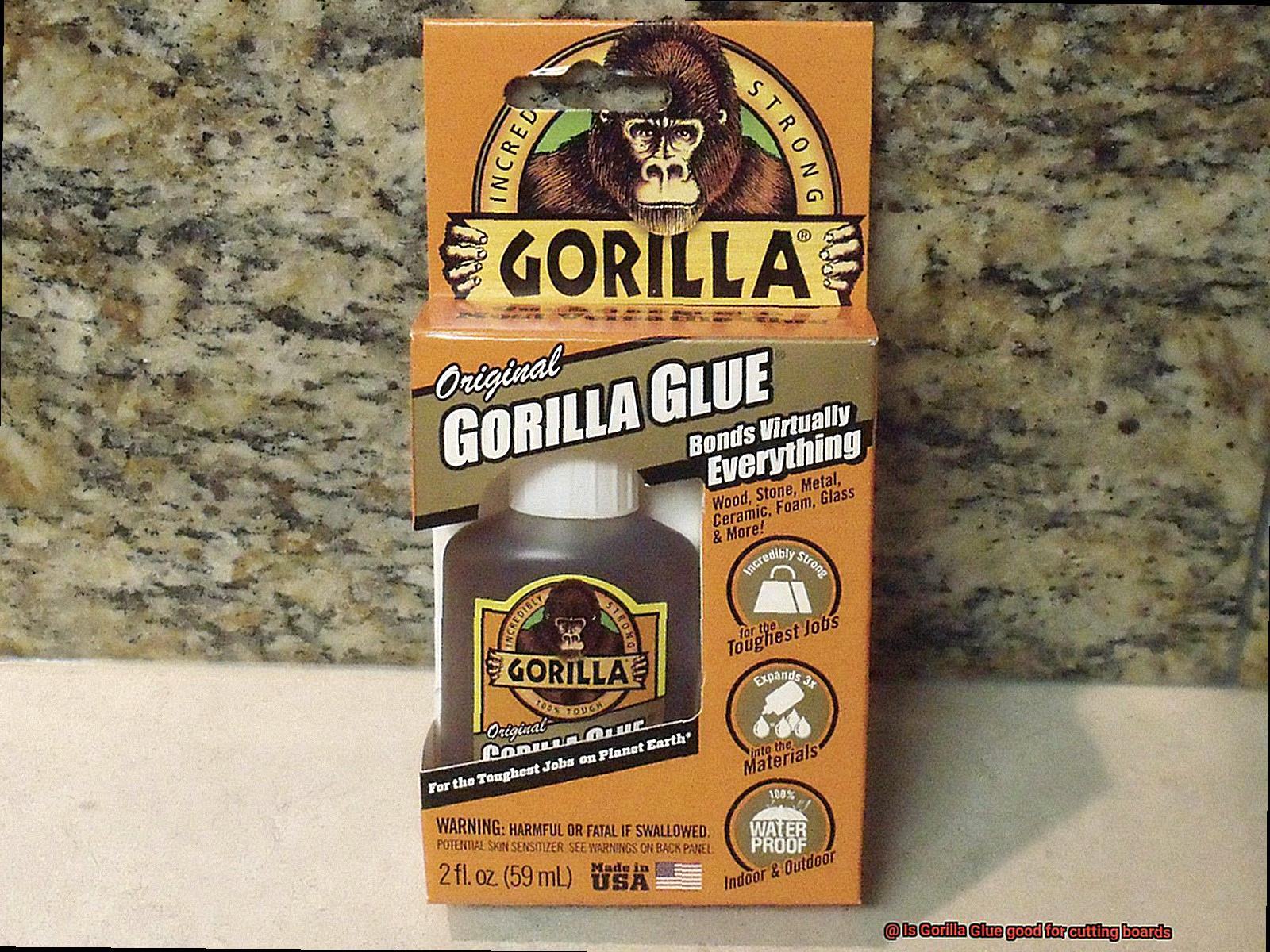
When it comes to bonding cutting boards together, Gorilla Glue is the ultimate adhesive choice. Its advantages are numerous, making it the go-to option for anyone looking to enhance the strength and durability of their cutting boards.
First and foremost, Gorilla Glue is known for its incredible strength and durability. It forms a tight bond that can withstand heavy use, ensuring that your cutting board stays intact and doesn’t fall apart over time. Say goodbye to wobbly boards and hello to a sturdy work surface.
Another advantage of Gorilla Glue is its water-resistant properties. We all know that cutting boards are constantly exposed to water and other liquids during food prep. Traditional wood glues tend to weaken and lose their bond when faced with moisture, but not Gorilla Glue. It’s designed to resist water, ensuring that your cutting board stays strong even after countless washes.
Versatility is also a key selling point for Gorilla Glue. It can be used on various materials like wood, metal, ceramics, and stone. So not only can you repair or bond your wooden cutting boards, but you can also fix other kitchen tools and utensils made from different materials. Talk about a multi-purpose adhesive.
Now let’s talk about safety in the kitchen. When it comes to using adhesives on cutting boards, it’s essential to choose one that is food safe. Luckily, Gorilla Glue has got you covered with its Gorilla Wood Glue variant. This specific formulation meets FDA standards for indirect food contact, giving you peace of mind when it comes to preparing your meals.
But wait, there’s more. Applying Gorilla Glue is a breeze. With its easy-to-use application process and various forms available (liquid, gel, or tape), you can choose the option that suits your needs best. Plus, Gorilla Glue requires minimal surface preparation, saving you time and effort.
Last but not least, Gorilla Glue is known for its longevity. Once applied, it creates a bond that can withstand the test of time. No more worrying about frequent repairs or replacements. Your cutting board will stay securely bonded for years to come.
Disadvantages of Using Gorilla Glue on Cutting Boards
Today, we’re delving into a sticky situation – the disadvantages of using Gorilla Glue on cutting boards. Though this adhesive may seem like a superhero, it falls short when it comes to our beloved chopping companions. So, don your apron and let’s explore why mixing Gorilla Glue and cutting boards is not a recipe for success.
Toxicity Troubles:
First and foremost, let’s discuss safety. Gorilla Glue contains isocyanate compounds that can be harmful if ingested. Imagine those toxic compounds sneaking into your food as you slice up vegetables – definitely not a recipe for a healthy meal.
Unyielding Bond:
Once Gorilla Glue dries, it forms an unbreakable bond that is nearly impossible to remove without damaging the surface. Repairing or replacing a damaged cutting board becomes an arduous task, often resulting in additional harm rather than good.
Expanding Woes:
Gorilla Glue has a mind of its own, expanding as it dries. This expansion can lead to uneven surfaces and gaps between glued pieces, compromising the stability of your cutting board. Say goodbye to smooth chopping experiences.
No Food-Safe Seal:
Unlike glues specifically formulated for kitchenware, Gorilla Glue lacks certifications or approvals for food contact safety. This means it may not comply with regulations in some regions and can pose health risks if used on cutting boards.
Unsightly Residue:
Imagine this: you’ve meticulously crafted a stunning cutting board, only to have Gorilla Glue leave visible marks or residue behind. Not exactly the elegant addition you were hoping for in your kitchen decor.
Warranty Woes:
Using Gorilla Glue on your cutting board may void any warranties or guarantees provided by the manufacturer. If something goes wrong down the line, you’ll be left holding the knife – and the responsibility.
Guidelines for Applying Gorilla Glue to Cutting Boards
Today, we’ll be exploring the art of adhesive application and sharing essential guidelines for using Gorilla Glue on your beloved cutting boards. Before you dive into this sticky situation, let’s go through some crucial steps to ensure a safe and effective bonding experience.
Step 1: Clean and Dry – Show Your Board Some Love
Begin by giving your cutting board a well-deserved spa treatment. Grab a sponge, warm water, and a mild detergent to thoroughly clean the surface. After rinsing away any grime, allow it to air dry completely. Remember, dirt, grease, or moisture can sabotage the strength of the glue bond.
Step 2: Smooth It Out – Embrace the Roughness
To create a surface that’s ready to grip onto the glue, gently sand your cutting board using fine-grit sandpaper. This will provide a rougher texture that enhances the adhesion. Afterward, ensure that no dust or debris is left behind, leaving you with a pristine surface ready for bonding.
Step 3: Dampen the Surfaces – Moisture Is Key
Gorilla Glue thrives on moisture, so it’s time to bring in some dampness. Lightly moisten both surfaces that are about to be glued together. However, exercise caution not to oversaturate the wood, as excessive moisture can cause undesirable consequences like warping. A damp cloth or sponge should do the trick – just enough to evenly distribute moisture.
Step 4: Apply Gorilla Glue – The Star of the Show
Now comes the moment you’ve been waiting for. Apply a thin layer of Gorilla Glue to one of the dampened surfaces. To ensure an even spread, enlist the help of a brush or small spatula. Remember, less is more – applying too much glue can lead to an untidy application and compromise the quality of the connection.
Step 5: Bring It Together – A Meeting of Surfaces
Press the surfaces firmly together, exerting even pressure across the entire area. To keep everything in place while the glue dries, employ the assistance of clamps or heavy objects. No wiggling or shifting allowed. This step is crucial for achieving a strong bond that will stand the test of time.
Step 6: Patience Is a Virtue – Let the Magic Happen
Now it’s time to exercise some patience and let the glue work its magic. Allow ample drying time for the Gorilla Glue to cure fully. The exact duration will depend on factors such as temperature and humidity. To find out the specific recommendations, consult the instructions on the glue container. Avoid disturbing or moving the cutting board until it has reached its full curing potential.
Is Gorilla Glue Food Safe?
The Surprising Truth
When it comes to DIY projects, finding the right glue can make all the difference. But what about when it comes to kitchen utensils? Can you trust Gorilla Glue to keep your cutting board intact and safe for food preparation? Let’s dive into the world of adhesives and uncover the truth about Gorilla Glue’s food safety.
Gorilla Glue, known for its incredible bonding properties, is not specifically marketed as a food-safe glue. The ingredients in Gorilla Glue include polyurethane resin, diphenylmethane diisocyanate, and other chemicals that may not be suitable for direct contact with food. In fact, the Gorilla Glue company itself states that their glues are not FDA-approved for any type of food contact.
So, what does this mean for your beloved cutting board or kitchen utensils? It means you need to exercise caution. If you choose to use Gorilla Glue on a surface that will come into direct contact with food, you must ensure that the glue is fully cured and dried before using the surface. Curing times can vary depending on factors like temperature and humidity, so be sure to follow the manufacturer’s instructions and allow sufficient time for the glue to dry completely.
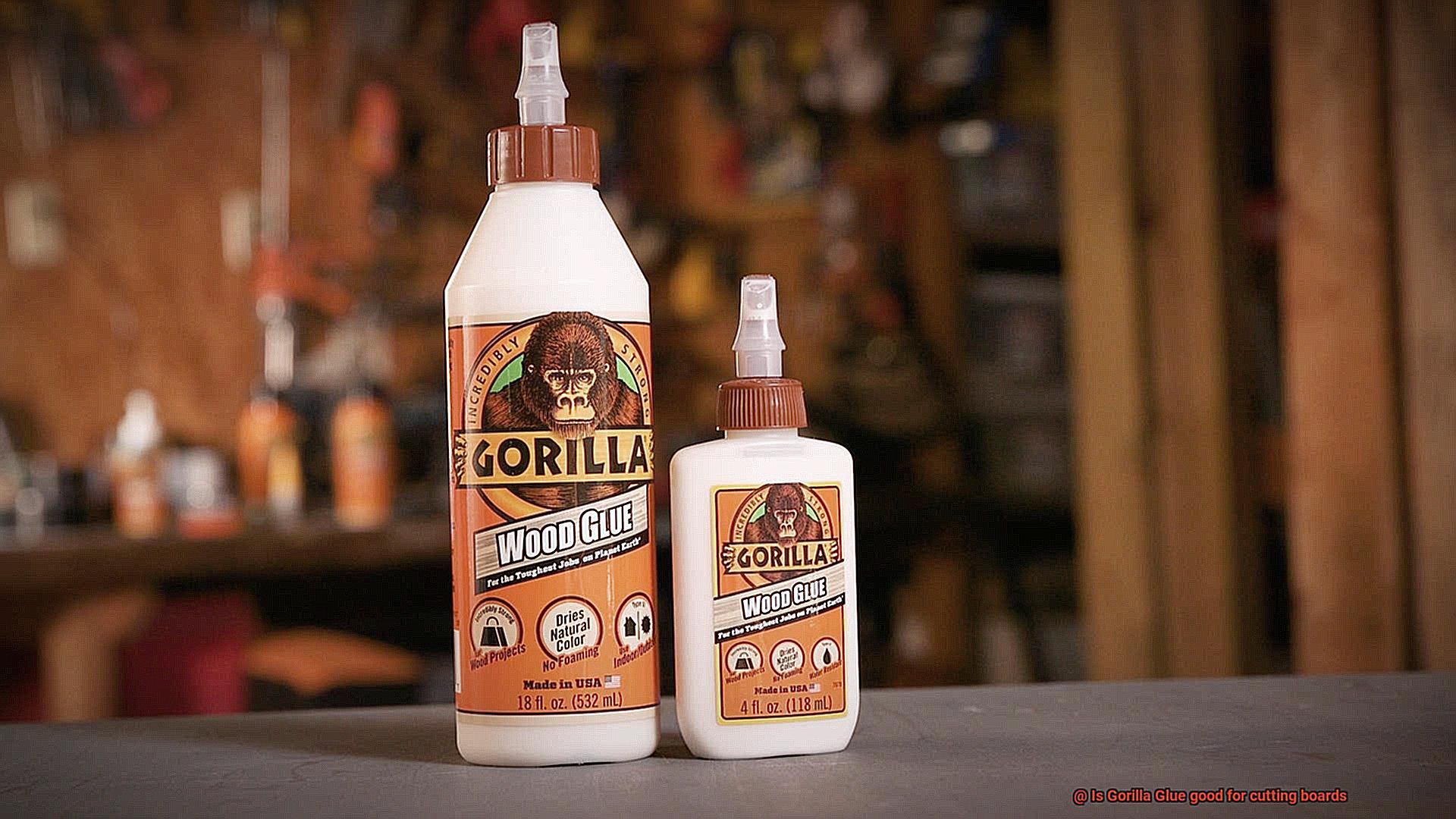
But why take unnecessary risks with your health and safety when there are glues specifically formulated for food-safe applications? FDA-approved wood glues or epoxy adhesives are designed to meet strict safety standards, providing a reliable bond without compromising the integrity of the food or affecting its taste or quality. These glues have undergone rigorous testing to ensure they are safe for use in kitchen utensils.
Finishing the Board After Applying Gorilla Glue
Crafting a cutting board requires attention to detail, especially when it comes to choosing the right adhesive. Gorilla Glue is renowned for its strength, but ensuring the safety of the materials in contact with food is paramount. In this comprehensive guide, we will explore the steps necessary to properly finish your cutting board after applying Gorilla Glue. By following these techniques, you can achieve both longevity and food safety.
Step 1: Sanding Down the Board
Before applying any finish, begin by meticulously sanding down the entire surface of your cutting board. This crucial step not only creates a smooth and even finish but also eliminates any excess glue that may have seeped out during the bonding process. Your board will now be primed for the next step.
Step 2: Choosing a Food-Safe Finish
To protect your cutting board and enhance its durability, it is imperative to select a food-safe finish. Consider options such as mineral oil, walnut oil, or coconut oil. These finishes deeply penetrate the wood, creating a barrier against moisture that can lead to warping or cracking over time.
Step 3: Applying the Oil Finish
Once you have chosen your preferred oil finish, pour a small amount onto the board’s surface. Using a clean cloth or paper towel, spread the oil evenly across the entire board. Allow the oil to soak in for several hours or overnight if possible. Afterward, carefully wipe off any excess oil to achieve a smooth and polished finish.
Step 4: Regular Maintenance
To ensure your cutting board maintains its optimal condition, regular maintenance is key. Periodically reapply the oil finish to prevent drying out and cracking of the wood. This simple step will significantly extend the lifespan of your cutting board and preserve its quality for many years to come.
Optional Step: Beeswax Finish
For an additional layer of protection, you can consider using a combination of beeswax and mineral oil. The beeswax acts as a sealant for the wood, while the mineral oil keeps it hydrated. Follow the manufacturer’s instructions carefully for proper application and achieve an extra level of durability.
Alternatives to Gorilla Glue for Cutting Boards
Well, you’re in luck. There are several options that can provide a strong and reliable bond, while also catering to your specific needs. Let’s dive into the world of alternatives and explore the advantages and disadvantages of each option.
First up, we have food-safe epoxy. This specialized adhesive is designed for applications where direct contact with food is involved. It boasts a strong bond, water resistance, and heat resistance, making it an excellent choice for cutting boards. However, it’s important to note that food-safe epoxy can be more expensive compared to other adhesives.
Next on the list is polyurethane glue, also known as PU glue or wood glue. This versatile adhesive forms a durable bond with wood and offers good water resistance properties. To ensure safety, be sure to choose a food-grade polyurethane glue for your cutting board.
For those who prefer traditional options, hide glue and fish glue are worth considering. Hide glue has been used in woodworking for centuries and provides a strong bond. Derived from animal collagen, it is reversible, allowing for easy repairs if needed. Fish glue, made from fish skin or bones, offers similar properties and can be an appealing choice for those seeking natural alternatives.
If you want to add extra strength and stability to your cutting board, mechanical fasteners like screws or dowels are a great option. By combining these fasteners with your preferred adhesive, you can achieve a secure and long-lasting bond that withstands heavy use.
When selecting an alternative to Gorilla Glue, it’s crucial to consider factors such as food safety, water resistance, ease of use, and personal preferences. Additionally, always read and follow the manufacturer’s instructions for proper application and safety precautions.
CCFKe_MhoNw” >
Conclusion
In conclusion, Gorilla Glue proves to be an excellent choice for bonding cutting boards, boasting unparalleled strength, remarkable water resistance, and impressive versatility. Its robust bond can effortlessly withstand heavy use, ensuring your cutting board remains steadfast over time. With its ability to resist water, this adhesive is a perfect fit for kitchen environments where exposure to moisture and liquids is inevitable.
Notably, Gorilla Glue stands the test of time, creating a bond that endures through the ages. Its array of forms – liquid, gel, and tape – makes application a breeze and renders it suitable for various projects.
However, there are some drawbacks to using Gorilla Glue on cutting boards. It contains toxic compounds that could pose harm if ingested; thus, caution must be exercised when employing it in food preparation areas. Moreover, removing the glue without causing damage can be quite the challenge due to its unwavering grip. Additionally, Gorilla Glue may lack specific certifications or approvals regarding food contact safety.
If you opt for Gorilla Glue on your cutting board, adhering to proper application guidelines and allowing ample drying and curing time before use is crucial. Alternatively, there exist alternative adhesive options specially formulated for food-safe applications.
Ultimately, whether you choose Gorilla Glue or another adhesive hinges upon your priorities and preferences.

